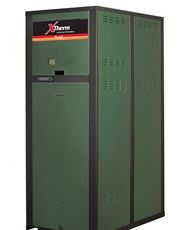 Are you unfamiliar with how air conditioning, or HVAC, systems work? HVAC is the Heating, Ventilating, and Air Conditioning (HVAC) method for conditioning the indoor environment of a building, usually with the intent of keeping the occupant comfortable. A hydronic HVAC system utilizes water as the primary fluid to transfer energy throughout the building. Water has outstanding heat transfer characteristics, along with other benefits, like being plentiful, non-toxic, “green," and inexpensive, that make it ideal for this purpose.
Are you unfamiliar with how air conditioning, or HVAC, systems work? HVAC is the Heating, Ventilating, and Air Conditioning (HVAC) method for conditioning the indoor environment of a building, usually with the intent of keeping the occupant comfortable. A hydronic HVAC system utilizes water as the primary fluid to transfer energy throughout the building. Water has outstanding heat transfer characteristics, along with other benefits, like being plentiful, non-toxic, “green," and inexpensive, that make it ideal for this purpose.
To deliver heat, the system must have a heat source, such as a boiler, and to provide cooling, the system must have a cooling source, such as a chiller or cooling tower. The heated or cooled water is pumped throughout the building to air handling units or terminal units (or other similar), where it transfers energy with air from the ventilation system before it recirculates to the heating or cooling source. The conditioned air is then delivered to the room.
Of course, this is an oversimplification, as there are a number of variations of hydronic HVAC systems, such as geothermal heat pump systems, radiant heating & cooling systems, fan coil, VAV, four-pipe, two-pipe, and so on. Just to give you a basic understanding, I will use an analogy
Imagine a large building (such as a school) is like the human body. It has different parts that must be heated or cooled (hot head, cold feet, etc.). The water in the HVAC system is similar to the blood in your body – it is the component that transports energy from one area to another. Water is circulated with pumps, just as the heart circulates blood. Without circulation, the system dies! The boiler (stomach or digestive system) converts fuel (food) such as natural gas into energy. The air handling system (lungs, or respiratory system) provides proper fresh air and ventilation. I could carry the analogy further, but does this help paint the picture?
So, a building may be viewed as a large “body” with a mechanical system designed to keep “human” bodies comfortable. At Heat Transfer Sales, we like to think of ourselves as similar to a “medical specialist”, the one you turn to when you need a high level of expertise in one specific field. For us, that field includes the application of equipment related to the heating, cooling, or circulation of water in a Hydronic HVAC system.
And, in a nutshell, that is what a hydronic HVAC system is.
Editor's Note: We first published this blog post in 2015, and it has quickly become one of our most popular blog posts to date. Whether you are simply looking for some elementary information about hydronic HVAC as a newbie to the HVAC field or you are looking for some basic information to train new engineers, you've landed in the right place. Here at Heat Transfer Sales, one of our main goals is to educate everyone about the efficiency and long-term sustainability of hydronic systems. Please subscribe to our blog so you don't miss a post!






Submit a Comment